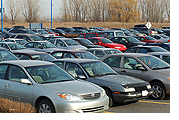|
||||||||||||||
| Social
change, population and industry Climate change will modify the changes in society, population and industry that are already underway as part of e.g. economic and cultural development, democratisation and general trends in wealth, health and liberty. Models are being used to study different socio-economic scenarios and the impact of climate change on them and Defra has some useful “key sheets” which includes work on impact on population in India (see 2nd link right). Social change is effected by many factors including by population, industry and climate change themselves and of course population both impacts on and is impacted on by climate change, so once again we have a feedback system. In an information age social change can be driven quite effectively by the media, irrespective of the message e.g. the impact of terrorism in the west or the campaigns for recycling or against drink driving, and it can be argued that this is already happening in terms of climate change and global warming. Nevertheless from a geography perspective we should consider the usual relationships between social change and industry and democracy and then consider the how climate change alters these.  Over
the last decade we have seen a growth in the use of 4X4 mpvs, arguably driven
by lifestyle advertising. Now we are beginning to see this trend reverse
with the introduction of more fuel efficient cars with similar labelling
to that on fridges and freezers. This is being driven by legislative developments
from congestion and parking charging to EU car specification requirements.
These changes will have impact on industry and commerce, but in essence
the biggest change will be social. Currently the equation between industrialisation,
urbanisation and economic development has a cost of increased energy consumption
and negative impact on climate. Rising numbers of democracies, individual
freedom and free market economies link with consumerism, more cars and more
air trips. It is logical therefore, but perhaps not palatable, to consider
that population and energy consumption should be the key focuses for reduction,
and that industrialisation as we have known it should cease. Indeed there
are those who believe that it will naturally diminish as we approach 2030.
In natural ecosystems, populations are determined by competition and finite
resources - can human behaviour outwit this relationship? Over
the last decade we have seen a growth in the use of 4X4 mpvs, arguably driven
by lifestyle advertising. Now we are beginning to see this trend reverse
with the introduction of more fuel efficient cars with similar labelling
to that on fridges and freezers. This is being driven by legislative developments
from congestion and parking charging to EU car specification requirements.
These changes will have impact on industry and commerce, but in essence
the biggest change will be social. Currently the equation between industrialisation,
urbanisation and economic development has a cost of increased energy consumption
and negative impact on climate. Rising numbers of democracies, individual
freedom and free market economies link with consumerism, more cars and more
air trips. It is logical therefore, but perhaps not palatable, to consider
that population and energy consumption should be the key focuses for reduction,
and that industrialisation as we have known it should cease. Indeed there
are those who believe that it will naturally diminish as we approach 2030.
In natural ecosystems, populations are determined by competition and finite
resources - can human behaviour outwit this relationship?More than 90% of future global population growth is predicted for the less developed nations, whereas population growth in Europe for example is already reducing and for many developed nations has been slowing for some time. The difference is that there is no time available for this to be emulated in the developing nations even if it were possible given their larger starting populations. Given the difficulty of predicting the impacts of so many variables on life on this planet, it is not surprising that some of the assertions and figures in the recommendations of the Stern Review are questioned in terms of accuracy. |
||||||